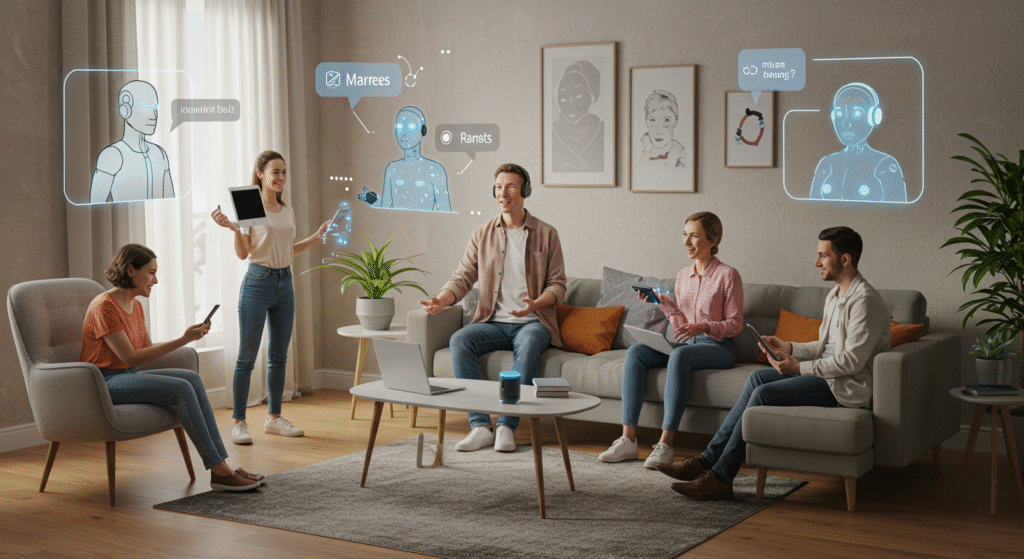Social & Interpersonal Science uncovers the secrets of effective communication and strong human connections. By understanding the principles of human interaction, you can enhance your relationships—whether personal or professional—and develop deeper empathy for others. This blog explores how this fascinating field improves relationships and communication in practical, measurable ways.
Table of Contents
- What Is Social & Interpersonal Science?
- The Role of Emotional Intelligence in Communication
- How to Apply Active Listening for Better Understanding
- Building Empathy Through Social Science
- Conflict Resolution Strategies Backed by Research
- Nonverbal Communication and Its Impact on Relationships
- The Science of Building Trust in Relationships
- How to Strengthen Bonds Through Shared Experiences
- Cultural Awareness and Its Role in Communication
- Future Insights From Social & Interpersonal Science
1. What Is Social & Interpersonal Science?
Social & Interpersonal Science examines the behaviors, emotions, and interactions between individuals.
This interdisciplinary field combines psychology, sociology, and communication theories to understand how people connect.
The insights drawn from this science are widely applied in therapy, workplaces, and even daily conversations.
Key Benefits of the Field:
- Insights on Behavior Patterns: It helps decode why people act the way they do.
- Tools for Healthier Communication: Learn techniques to prevent misunderstandings.
- Relationship Building Foundation: Empowers people to develop meaningful connections.
Example in Action:
Imagine a workplace dispute. Applying principles from Social & Interpersonal Science, the manager identifies underlying issues, fostering resolution and trust among team members.
This science goes beyond theory, offering practical tools for improving the human experience.
2. The Role of Emotional Intelligence in Communication
Emotional intelligence (EI) is the ability to recognize, understand, and manage your emotions while also empathizing with others.
Research highlights that emotionally intelligent individuals form stronger bonds and resolve conflicts more effectively.
Key Elements of EI:
- Self-awareness – Understanding your emotional triggers.
- Self-regulation – Managing impulses during heated interactions.
- Empathy – Recognizing others’ feelings to enhance connection.
- Social Skills – Building rapport and creating a positive environment.
Studies show emotionally intelligent leaders foster cultures of trust and open communication, leading to higher productivity in teams.
Similarly, in personal relationships, EI creates healthier dynamics by reducing emotional outbursts and improving conflict resolution.
Practical Tip:
Pause before reacting in stressful situations. Label emotions as they arise—this simple act can shift your energy toward productive communication.
3. How to Apply Active Listening for Better Understanding
Active listening is more than hearing—it involves fully engaging with the speaker and responding thoughtfully.
This technique fosters mutual understanding and validates emotions, keeping relationships strong.
Steps to Master Active Listening:
- Maintain eye contact without distractions.
- Reflect emotions by restating what you heard.
- Ask clarifying questions like, “Can you tell me more?”
- Avoid judgment, focusing on the speaker’s perspective.
Benefits:
Research in Social & Interpersonal Science emphasizes that active listening reduces misunderstandings and deepens trust. Whether in personal conversations or workplace meetings, it creates stronger social bonds.
Example:
Instead of interrupting your partner during an argument, you might say, “It sounds like you’re worried about…” This shows attentiveness and sparks a more constructive dialogue.
4. Building Empathy Through Social Science
Empathy—the ability to relate to another’s feelings—is a crucial element in meaningful relationships. Social & Interpersonal Science provides tools to foster empathy in daily interactions.
Ways to Build Empathy:
- Practice Perspective-Taking – Imagine yourself in someone else’s shoes.
- Engage in Active Observation – Notice body language and tone.
- Participate in Empathy Exercises – Journaling or mindfulness practices can help you better connect with others’ experiences.
Empathy fosters collaboration, reduces resentment, and strengthens trust, making it essential in both personal and professional contexts.
Real-Life Application:
Imagine mediating a family argument. Empathy allows you to bridge the gap between differing viewpoints, encouraging peaceful resolutions.
5. Conflict Resolution Strategies Backed by Research
Conflict is inevitable, but it doesn’t have to damage relationships. Social & Interpersonal Science identifies strategies to resolve disputes while preserving mutual respect.
Proven Methods:
- Identify Underlying Needs – Surface hidden concerns driving conflict.
- Use “I” Statements – Express your feelings without blaming others.
- Seek Mutual Solutions – Focus on creating compromises.
Research shows that addressing conflict early prevents escalation, saving relationships from breakdown.
Example:
A friend feels left out of your plans. Instead of defending yourself, you might say, “I’m sorry you felt excluded. How can I involve you moving forward?”
6. Nonverbal Communication and Its Impact on Relationships
Messages aren’t just delivered through words—nonverbal cues such as gestures and expressions convey up to 93% of human communication.
Key Nonverbal Elements:
- Facial Expressions
- Posture and Body Language
- Tone and Pitch of Voice
- Eye Contact
Understanding these cues can prevent misinterpretations and improve emotional connections.
For example, maintaining consistent eye contact signals interest and attentiveness, while crossed arms may indicate defensiveness.
Pro Tip:
Align your body language with verbal messages. A calm voice paired with open gestures creates trust and clarity in communication.
7. The Science of Building Trust in Relationships
Trust is the foundation of any strong relationship. Social & Interpersonal Science identifies credibility, reliability, and emotional safety as key components of trust.
Tips to Build Trust:
- Follow through on promises consistently.
- Create open, judgment-free communication spaces.
- Show vulnerability where appropriate, demonstrating authenticity.
By understanding how trust develops, you can consciously build stronger personal and professional relationships.
8. How to Strengthen Bonds Through Shared Experiences
Shared experiences are powerful tools for strengthening bonds between individuals.
Engaging in activities together fosters a sense of connection and creates lasting memories.
These experiences could range from tackling challenges as a team to enjoying leisure activities like traveling or collaborative hobbies.
To strengthen bonds through shared experiences, consider the following ideas:
- Plan regular group outings or shared meals to cultivate a sense of belonging.
- Work together on a common goal, such as volunteering for a cause or completing a project.
- Participate in workshops or classes that encourage teamwork and learning.
By prioritizing shared experiences, you create opportunities for deeper understanding, mutual support, and a stronger sense of community.
Experiencing moments together strengthens relationships by creating lasting memories and emotional connections.
Examples:
- Volunteering or working on shared goals.
- Engaging in hobbies or activities together, like hiking or music.
- Setting traditions, such as weekly family dinners.
Social & Interpersonal Science proves that collaboration on shared interests deepens bonds and fosters mutual growth.
9. Cultural Awareness and Its Role in Communication
Cultural awareness plays a crucial role in shaping effective communication.
It involves understanding, respecting, and valuing the diverse perspectives, traditions, and practices of different cultures.
When individuals are culturally aware, they can better interpret verbal and non-verbal cues, avoid miscommunication, and foster a more inclusive and harmonious environment.
This skill is particularly important in globalized settings, such as international workplaces, where diverse backgrounds converge.
By acknowledging cultural differences and seeking common ground, people can build stronger relationships, resolve conflicts more effectively, and collaborate toward shared goals with greater empathy and understanding.
Cultural diversity influences communication styles. Recognizing this enhances cross-cultural relationships and prevents unintentional offense.
Practical Steps to Cultivate Awareness:
- Learn about different cultural norms.
- Respect language and nonverbal differences.
- Avoid assumptions—ask when unsure about cultural preferences.
10. Future Insights From Social & Interpersonal Science
Key Areas of Focus for Future Research:
- The impact of emerging technologies, such as artificial intelligence, on interpersonal communication and relationships.
- The role of virtual and hybrid environments in shaping social connections.
- Strategies to address loneliness and isolation in increasingly digital societies.
- How cultural globalization continues to influence interpersonal dynamics and identity.
- The long-term effects of social media on empathy and emotional intelligence.
Emerging technologies like AI and virtual reality offer new possibilities for improving human communication.
Social scientists are exploring how these tools can enhance empathy, gamify personal growth, and reduce global conflicts.
A Comparative Table of Key Ideas:
| Principle | Key Focus | Benefits | Example Application |
|---|---|---|---|
| Emotional Intelligence (EI) | Managing emotions effectively | Reduces misunderstandings | Conflict resolution at work |
| Active Listening | Full engagement in conversations | Builds trust | Mediating personal disputes |
| Empathy | Relating to others’ feelings | Deepens relationships | Therapy or counseling sessions |
| Nonverbal Communication | Understanding body language | Improves mutual understanding | Cross-cultural workplace meetings |
FAQs
Q1. What is Social & Interpersonal Science?
It’s the study of human behavior and interaction dynamics, focusing on enhancing relationships and communication skills.
Q2. How does active listening improve relationships?
By showing genuine interest and understanding, active listening builds trust and reduces conflict.
Q3. What role does empathy play in communication?
Empathy fosters emotional connection, helping individuals relate better to one another.
Q4. Can nonverbal communication affect relationships?
Yes, nonverbal cues like eye contact and body language strongly impact interactions.
Q5. How do shared experiences strengthen bonds?
They create emotional connections and shared memories that deepen relationships.
Q6. What is an example of social learning?
Observing and imitating others’ behavior, such as a child learning to tie their shoes by watching a parent.
Q7. What is an example of interpersonal learning?
Engaging in active listening during conversations to better understand another person’s perspective.
Q8. What skills are interpersonal skills?
Interpersonal skills include communication, empathy, teamwork, active listening, and conflict resolution.
Q9. What are social skills?
Social skills are the abilities that enable individuals to interact effectively and harmoniously with others, including verbal and non-verbal communication, collaboration, and relationship management.
Q10. How to teach learners with interpersonal intelligence?
Encourage group activities, collaborative projects, and discussions that promote interaction. Use role-playing, peer teaching, and opportunities for learners to share their perspectives and work together to solve problems.
Final Thought
Developing strong social skills and fostering interpersonal intelligence are essential for success in both personal and professional contexts. By creating environments that encourage collaboration, communication, and empathy, individuals can build meaningful relationships and contribute positively to their communities.












